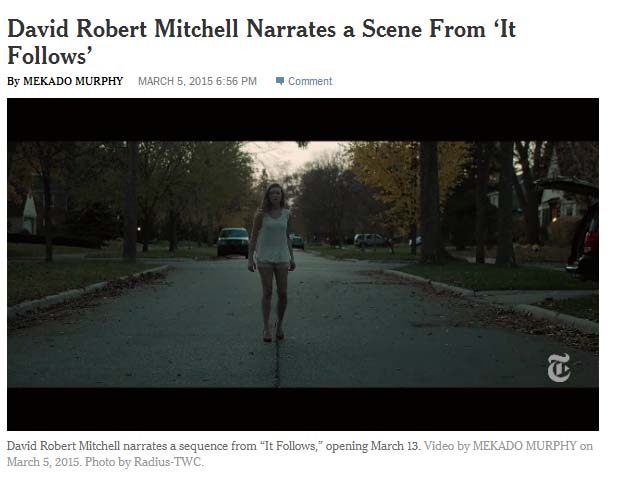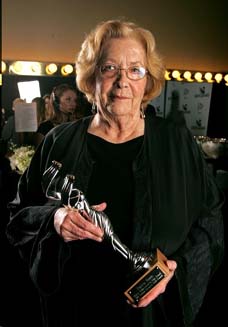ALL OF HIS FILMS "HAVE IN SUCH A PROFOUND WAY A STRUGGLE WITHIN THEMSELVES"
 At Desistfilm, Victor Bruno uses the film art of Brian De Palma as an example to help explain what it is that makes a good film good. Stressing in the intro that films are not about their plots, Bruno delves into what he calls the symmetry of Brian De Palma. "How does [this symmetry] come to reality?" Bruno asks. "When do we detect it in his work? The first thing we have to understand is that it is not only visual, but also thematic and spiritual. Like any good filmmaker, he is concerned about bringing ideas into images. I will use two of his films to try to illustrate a little of this idea. The films are Obsession (1976) and Body Double (1984), made almost a decade apart but with common themes and visual logics.
At Desistfilm, Victor Bruno uses the film art of Brian De Palma as an example to help explain what it is that makes a good film good. Stressing in the intro that films are not about their plots, Bruno delves into what he calls the symmetry of Brian De Palma. "How does [this symmetry] come to reality?" Bruno asks. "When do we detect it in his work? The first thing we have to understand is that it is not only visual, but also thematic and spiritual. Like any good filmmaker, he is concerned about bringing ideas into images. I will use two of his films to try to illustrate a little of this idea. The films are Obsession (1976) and Body Double (1984), made almost a decade apart but with common themes and visual logics."Both films are primarily about the perception of the truth and truth itself (and here the term 'truth' stands for reality itself). De Palma’s camera is the mediator, the howling beast on the borderline that separates the deception from the ecstasy of the discovery. De Palma is interested in halves. In short, dichotomy: past and future; truth and lie; damnation and forgiveness; me and you; life and death.
A SPIRITUALIST APPROACH TO THE SYMMETRY
"Of course, the most obvious feature he presents to display this interest in halves is the split-screen. Unlike some say, the split-screen is not a 'fetishist' interest that he has; it is not a gimmick. There are, of course, things that it is: It is a heritage from Alfred Hitchcock (the viewer knows everything in advance and thus he suffers more than the unaware character of the film). But it is, also, a spiritualist approach to the symmetry. When the screen is parted in two diametric halves, De Palma is trying to put the viewer in an omniscient position, a place in which we can receive all the information the film has on hand. We assume two perspectives: the one of the victim and the one of the hero (and/or of the villain). When the screen is in a single piece, the maximum the film can present to us is a medley of feelings, emotions and interests (as presented in the long takes), but it lacks a fundamental feature in a Brian De Palma picture: organization. The greatest struggle of a DePalmian character is to understand what he is living and the situation he is in and in order to do it he has to organize the facts and the feelings he is experiencing.
"But until he gets to the organization (and it does not mean you will survive in this world), the character still have to discover what is truth and what is deception. These are the themes of Obsession and Body Double. Early on the former we get what perhaps is the best shot of the career of Brian De Palma: with the left and the right sides of the screen separated by a wall, on the former we see Cliff Robertson’s character reaching for a gun and on the latter we see John Lithgow’s character trying to get information from a little kid who may or may not know anything about the kidnapping of Robertson’s daughter and wife.
"Of course, De Palma is not Wes Anderson: the screen is not split pin-point on the middle. Of course, later in his career he would be more demanding about the way he symmetrically splits his screen (more pronouncedly in Blow Out with the split diopter). But right now it doesn’t matter—it is a split screen. We have to different actions happening in two different places. Both are acts of violence—Robertson’s mind is going to crack and he is considering to kill someone; Lithgow is making pressure on a young kid. But there is a third layer, the layer that separates truth and lie: Lithgow is not interested at all in helping his friend—the truth is that he wants to drive Cliff Robertson crazy and he wants his money. So there you have it: the borderline of reality and deception. Truth and lie. Friendship and betrayal. Good intentions and bad acts. (And it’s a brilliant use of CinemaScope, don’t you agree?)"
That is just an excerpt-- go to Desistfilm to read the whole thing.
Updated: Tuesday, March 17, 2015 8:09 PM CDT
Post Comment | Permalink | Share This Post





 The March 2015 issue of
The March 2015 issue of 



 Patricia Norris, the costume designer for Brian De Palma's Scarface, passed away February 20 of natural causes,
Patricia Norris, the costume designer for Brian De Palma's Scarface, passed away February 20 of natural causes,  "Let me put it this way. After Scarface, I almost didn't want to work in the movies again. You're making a movie that's not about nice people, being made by people many of whom aren't nice people... It was tense, pretty distant. I don't like being condescended to. I worked with David Lynch for over twenty-five years because he was a nice person and an artist, and he appreciates the artistry other people bring to their work.
"Let me put it this way. After Scarface, I almost didn't want to work in the movies again. You're making a movie that's not about nice people, being made by people many of whom aren't nice people... It was tense, pretty distant. I don't like being condescended to. I worked with David Lynch for over twenty-five years because he was a nice person and an artist, and he appreciates the artistry other people bring to their work.